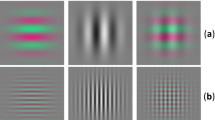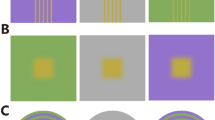Summary
A computer-driven colour television monitor with separate red, green and blue input channels is employed to measure the luminance-difference thresholds for the occurrence of subjective contours, when induction fields and background are of unequal colour. These thresholds are strongly dependent upon the size of the colour difference between the two fields. With increasing difference in colour between induction fields and background, the luminance-difference thresholds necessary to just obtain the subjective contour-effect increase. Various explanations are discussed. Chromatic aberration is not likely to be the main cause for this colour effect, although it has some detrimental influence. At the level of colour-coding mechanisms, lateral interactions between cones or Pi-mechanisms of the same type and interactions between opponent colour codes of the same type are considered. Finally, attention is given to possible psychological factors.
Similar content being viewed by others
References
Alpern M (1964) Relation between brightness and color contrast. J Opt Soc Am 54:1491–1492
Bender BG (1973) Spatial interaction between the red and green sensitive colour mechanisms of the human visual system. Vision Res 13:2205–2218
Brigner WL, Gallagher MB (1979) Subjective contours, apparent depth or simultaneous brightness contrast. Percept Mot Skills 38:1047–1053
Brussell EM, Stober SR, Bodinger DM (1977) Sensory information and subjective contours. Am J Psychol 90:145–156
Coren WL, Theodor LH (1975) Subjective contour: The inadequacy of brightness contrast as an explanation. Bull Psychon Soc 6:87–89
Cornsweet TW (1970) Visual perception. Academic Press, New York
Dumais ST, Bradley DR (1976) The effects of illumination level and retinal size of apparent strength of subjective contours. Percept Psychophys 4:339–345
Frisby JP, Clatworthy JL (1975) Illusory contours: curious cases of simultaneous brightness contrast. Perception 4:349–357
Gregory RL (1977) Vision with isoluminant colour contrast: I. A projection technique and observations. Perception 6:113–119
Guth SL, Donley NJ, Marocco RT (1969) On luminance additivity and related topics. Vision Res 9:537–575
Helmholtz H von (1924) in Southall. J.P.C.: Helmholtz's Treatise on Physiological Optics I and II. Dover Edition 1962
Jory MK, Day RH (1979) The relationship between brightness contrast and illusory contours. Perception 8:3–9
Kanizsa G (1979) Organisation in vision. Praeger, New York
Kinnear PR (1979) The effects of coloured surrounds on colour naming and luminosity. Vision Res 19:1381–1391
Kerr L (1974) Detection and identification of monochromatic stimuli under chromatic contrast. Vision Res 14:1095–1105
Kerr L (1976) Effect of chromatic contrast on stimulus brightness. Vision Res 16:467–468
Mitsuboshi M, Mitsbuoshi T (1980) The specificity of interactions among the visual photopic mechanisms as revealed by spatial on effects. Jap Psychol Res 22:197–206
Noorlander C, Heuts MJG, Koenderink JJ (1981) Sensitivity to spatiotemporal combined luminance and chromaticity contrast. J Opt Soc Am 71:453–459
Oyama T, Mitsuboshi M, Kamoshita T (1980) Wavelength specific brightness contrast as a function of surround luminance. Vision Res 20:127–136
Vos JJ, Walraven PL (1971) On the derivation of the foveal receptor primaries. Vision Res 11:799–818
Weert ChMM de (1980) Die Bedeutung von Farbkonturen verglichen mit der Bedeutung von Helligkeitskonturen. Farbe und Design 15/16:89–93
Wittebrood JEM, Wansink MG, Weert ChMM de (1981) A versatile colour stimulus generator. Perception 10:63–69
Author information
Authors and Affiliations
Rights and permissions
About this article
Cite this article
de Weert, C.M.M. The role of colours in the formation of subjective contours. Psychol. Res 45, 117–134 (1983). https://doi.org/10.1007/BF00308664
Received:
Issue Date:
DOI: https://doi.org/10.1007/BF00308664




